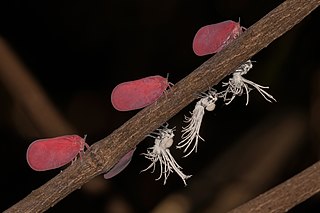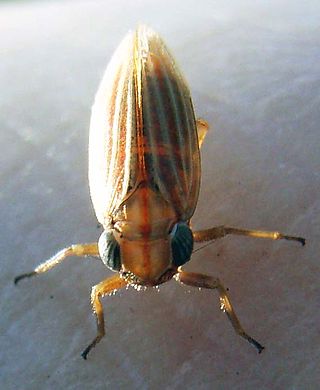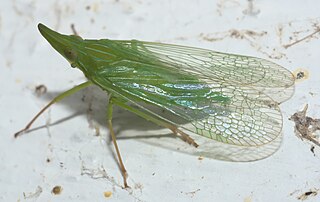
The family Fulgoridae is a large group of hemipteran insects, especially abundant and diverse in the tropics, containing over 125 genera worldwide. They are mostly of moderate to large size, many with a superficial resemblance to Lepidoptera due to their brilliant and varied coloration. Various genera and species are sometimes referred to as lanternflies or lanthorn flies, but neither do their heads emit light, nor are they even distantly related to flies.

Flatidae are a family of fulgoroid planthoppers. They are cosmopolitan in distribution and are distinguished from others in the superfamily by a combination of characters. Like all other planthoppers, they suck phloem sap of plants. Some species are known to communicate with vibrations through the plant stems. Communication may be with mates, or with ants that tend the nymphs, protecting them and gathering honeydew secretions. Adults of some species have brightly coloured forewings which are tougher and known as tegmina unlike the membranous hindwings which are used for flight. Although a few can be identified by their coloration, most species requires dissection and examination under a microscope with access to literature on already described species.

Issidae is a family of planthoppers described by Spinola in 1839, belonging to the order Hemiptera, suborder Auchenorrhyncha superfamily Fulgoroidea.

Caliscelidae is a family of planthoppers, sap-sucking insects that belong to the order Hemiptera, suborder Auchenorrhyncha and superfamily Fulgoroidea. They are somewhat anomalous and have often been included within the family Issidae. Studies made in 2013 of the phylogeny of the Issidae and other groups using molecular techniques support the treatment of the group as a separate family. Sexual dimorphism can be marked. Some members of the family are called piglet bugs due to the shape of their snout. A particularly aberrant genus described in 2011 from India, Formiscurra, has males that resemble ants.

Stobaera is a genus of delphacid planthoppers in the family Delphacidae. There are about 14 described species in Stobaera.

Flatormenis is a genus of flatid planthoppers in the family Flatidae from North and central America. There are about 15 described species in Flatormenis.

Melanoliarus is a genus of cixiid planthoppers in the family Cixiidae. There are at about 50 described species in Melanoliarus, which are common and widespread in the Nearctic and Neotropics.

Achilidae is a family of planthoppers, sometimes called "achilids" in the order Hemiptera. There are at least 520 described species in Achilidae.

Pintalia is a genus of cixiid planthoppers in the family Cixiidae. There are at least 50 described species in Pintalia.

Rhynchomitra is a genus of dictyopharid planthoppers in the family Dictyopharidae. There are about five described species in Rhynchomitra.

Anotia is a genus of derbid planthoppers in the family Derbidae. There are at least 20 described species in Anotia.

Thionia is a genus of planthoppers in the family Issidae. There are at least 60 described species in Thionia. However, several genera have been split off from Thionia reducing the number of species.

Asiracinae is a subfamily of delphacid planthoppers in the family Delphacidae. There are at least 30 genera and 180 described species in Asiracinae, which probably has a world-wide distribution.
Pelitropis is a genus of tropiduchid planthoppers in the family Tropiduchidae. There are about five described species in Pelitropis.
Tangiini is a tribe of tropiduchid planthoppers in the family Tropiduchidae. There are about 10 genera and at least 30 described species in Tangiini.

Dictyopharinae is a subfamily of dictyopharid planthoppers in the family Dictyopharidae. There more than 100 genera and 500 described species in Dictyopharinae.

Acanaloniidae is a family of planthoppers. It is sometimes treated as a subfamily of Issidae.

The Flatinae are a subfamily of planthoppers, erected by Maximilian Spinola in 1839. Genera have been recorded from all continents except Antarctica: especially in tropical and subtropical regions.

Acanalonia similis is a species of planthopper in the family Acanaloniidae. It is found in Texas, New Mexico, and Arizona. It is quite visually similar to Acanalonia invenusta, but though the two can be differentiated as A. similis has more prominent reticulation across its elytra than A. invenusta. A. similis measures 4.2 - 4.9 mm long.


















